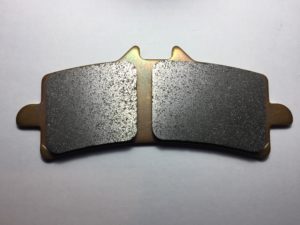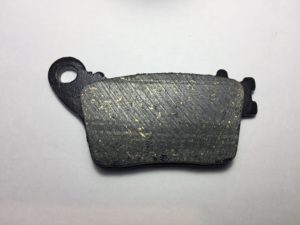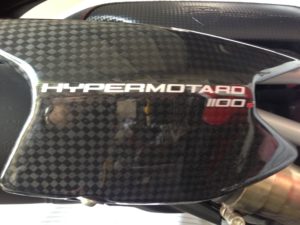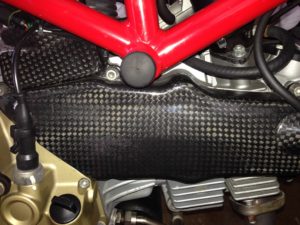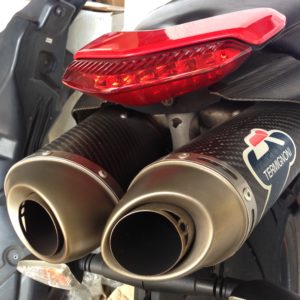For this post I am very excited to have as a co-host Mr. Tim Huber, a moto-journalist from Los Angeles. Tim and I met back in January at the Women’s Motorcycle Show, where he was covering the event. We found that we had in common a love of two wheeled machines and writing about them. We also enjoy watching motorcycle racing of just about any type and we enjoy the technical aspects of things such as motorcycle components (frames, electronics, etc.).
Tim & I would like to dedicate this piece to the memory of Nicky Hayden. Like motorcycle frames, Nicky displayed strength along with flexibility. He provided underlying support to so many and became the foundation around which his race teams were built. Those who attached themselves to him knew the metal from which he was made and were dedicated to making him shine.
#RideonKentuckyKid Race in peace #69
Welcome, Tim! Please tell our readers a little bit about yourself and how you got your start as a journalist.
Tim: Hey, my name’s Tim Huber, I’m a 27-year-old motorcycle journalist living (and riding) in Los Angeles. Motorcycles have been the primary focus in my life for the past half-decade or so. I love sport bikes, canyon and track riding, but I can have fun on just about anything with two wheels. In addition to riding modern sport bikes, (mainly supersports), I also buy vintage Hondas and rebuild them with a friend. When I’m not riding or wrenching I’m usually writing, reading, looking at or talking about bikes. I also enjoy playing motorcycle racing video games (Ride 2 and the MotoGP series) in addition to watching real racing, another serious-passion of mine.
Because I personally knew very few other riders when I bought my first scoot, (with almost none of them being sport or race enthusiasts), I went to the interwebs to share my passion for high-performance two-wheelers and organized competition. I began posting stories on the website (and app) Eatsleepride (ESR), mainly as a way of sharing views and discussing bike-related topics with fellow riders. After months of posting I was contacted by staff at ESR and was offered a press pass to an event if I wanted to cover it for them. All the work for them at that point was voluntary (without pay) but I enjoyed getting free passes to events I would be attending anyway and getting to go to press days that were closed to the public was just an added bonus. Eventually my writing for ESR led to me having the experience and confidence to start receiving paid work as a moto-journalist until I was able to transition to doing it full time.
After randomly watching some Mark Neale racing documentaries on Netflix shortly after I started riding, I got bit by the race-bug and almost instantly became an avid fan of road racing. Around this same time I stumbled across the Rossi v. Stoner battle at Laguna that would only compound my interest. The speed, the strategy, the skill, the characters, the bikes, I loved (and continue to love) everything about it. I started out just watching MotoGP but by the start of the next season I was following Moto 2 & 3 and World Superbike (WSBK), the TT, NW200, Ulster GP, etc. I couldn’t get enough, so the inception of MotoAmerica was more than welcome news to me. The drama and excitement brought on by two world-class racers going head-to-head, knowing either can wreck at any moment is unlike anything else I’d ever experienced.
Even someone who’s never thrown a leg over a bike in their life can still thoroughly enjoy the spectacle that is a motorcycle racer dragging a knee at triple-digit-speeds or the drama of an overtake on a final lap. Having said that, having experience riding a motorcycle, especially a sport bike, helps you fully grasp the magnitude of the skill professional motorcycle racers possess. There’s also undeniably an element of enjoying the evolution of engineering and technology used in motorcycle racing, as grasping exactly what is happening under the fairings is far more impressive than most probably realize.
Daphne: Thank you. That’s a fantastic introduction, Tim! Your passion and enthusiasm for the sport is infectious.
Now, why frames? What makes them so interesting to me, as a chemist?
Well, most are made of metals, or metal alloys (mixtures of more than one metal in a particular amount, which is often, in racing applications, proprietary to the manufacturer’s process). Metals are of great interest to me as a chemist since they are some of the inorganic substances that have been studied the longest, many even prior to the development of chemistry as a field, during the time of the alchemists! Metals have incredibly interesting properties, and many are beautiful to look at, as well. (We’ll get into the properties of some of the metals a little later; please read on…)
OK – over to you, Tim. As a rider and a moto-journalist, please talk us through what it is about motorcycle frames and the materials from which they are made that really causes you to take a shine to them.
Tim: From learning more about the bikes used in racing (or on the street) I could better understand what the riders were doing and why they were doing it. Being better acquainted with how everything works not only allows me to learn from watching professionals, but it also allows me to have a greater appreciation for the ingenuity that’s responsible for state-of-the-art components of modern race-machines, production-based or prototype. Without the remarkable technical achievements of those developing race bikes, today’s fastest motopilots would never be able to consistently achieve the corner-speed, lean angles, acceleration and raw performance that add up to breathtaking lap times. (It’s not until you have a go at a track that’s used as a venue for professional racing that you realize how phenomenal professional bikes and riders are. My fastest lap being almost ten-seconds slower than even the slowest on the professional grid make their superhuman abilities abundantly and depressingly clear).
For this post we’re going to be examining the semi-literal backbone of every motorcycle – the frame. Motorcycle frames house the engine and attach to the bike’s sub-frame (tail-section) fork and swing-arm. But these metal structures do more than connect the parts that make up the sum that is a motorcycle — decades of development have resulted in some truly impressive frames that enable today’s fastest two-wheelers to accelerate, brake and corner better than ever before.
As metallurgy has evolved over those decades, significant advancements in engineering have been possible, giving developers the tools needed to squeeze better performance from these geometric metal designs. This evolution in metallurgy has also resulted in better performing (faster and more powerful) engines, making the need for brilliant frame development that much more necessary to compensate for today’s 250+HP machines. Advancements in metallurgy have advanced just about every part found on a bike, from valve-springs to brake-rotors.
Understanding exactly what it is that frames do, how, why and when they flex, is vital to grasping the technology. Because the article, “Flexi-Flyer Frames Explained by Redbull MotoGP Riders”, in rideapart.com, has recently done such a wonderful job visually depicting exactly what I just mentioned, I’ll let the video in the link below demonstrate a frame in action. (If you are Formula 1 fan, you might just recognize a familiar face in that video, as well.)
https://rideapart.com/articles/flexi-flyer-frames-explained-redbull-motogp-riders
Daphne: Wow, Tim, that is such a great article and cool video. Thanks for finding that and bringing it to our attention.
Since my husband has two KTM’s in the “paddock”, I was looking at KTM’s site the other day, and this is what they noted about the frame of their new 1290 Super Adventure S, 2017 model:
“The chrome-molybdenum steel trellis frame makes a major contribution to the bike’s excellent chassis geometry. It’s a rugged, laser-cut, robot-welded thing of beauty with a glorious surface finish. And at only 9.8 kg, it helps to keep the total, unfueled weight at a spectacular 215 kg. All muscle, zero fat.”
http://www.ktm.com/travel/1290-super-adventure-s/
Ooh, la la! When I saw the term “chrome-molybdenum” (or chrome-moly, as it’s sometimes known) I went straight to my periodic table phone app (I know; pretty geeky!) to take a look at some of the properties of chromium and molybdenum. They happen to be part of the “transition metals”. If you view the Periodic Table of the Elements, these metal elements are purposely set apart as a “block” in the middle section, where the Table takes a “dip” in the number of rows. Their placement there has to do with their unique electron arrangements. Many of our most useful industrial metals, such as iron, copper, titanium, etc., are also transition metals. With chromium and molybdenum having nearly identical electronic arrangements (in the same vertical column, or “group” but just one row apart), this also gives them very similar properties, such as high melting points, high densities, and the ability to form alloys. Chrome-moly steel is one of those alloys. Both chromium and molybdenum on their own can be used to make steel harder, and molybdenum increases strength and corrosion resistance, as well. (I think that those design engineers at KTM know a thing or two about chemistry!)
As mentioned in the video, aluminum is the main component of many frames used in racing. Aluminum is much less dense than steel or chrome-moly steel, and it is, as indicated in the video, its low density that allows an aluminum frame to be very light weight. However, as was also noted, the steel frame is significantly stronger than an aluminum frame, requiring less material. So, as Tim says in the next paragraph, it’s all about balancing the various factors involved…back to you, Tim.
Tim: Like everything in life, balance is key to finding success when engineering a motorcycle frame. It needs to flex enough to soak-up the imperfections of the tarmac on a road or track, but must be rigid enough to compensate for the engine’s power and the machine’s overall weight and consequent stress put on the frame in any given situation. I once heard the engineer who developed the Suzuki GSXR’s frame for many years say that frames need to “bend like a tree” — a very simple yet very apt analogy.
The importance of the frame and suspension on a motorcycle can’t be overstated. The reason so many manufacturers (and high-performance aftermarket components companies) highlight these features and their being adjustable should speak to their level of importance. The bike’s frame is the first line of defense against imperfect roads or surfaces before any of the traditional suspension components start doing their job. Setting your bike up for optimal performance makes all the difference in the world; I can’t tell you how much more natural proper body position feels once you dial in your bike’s settings. This is why professional teams put so much effort and energy into scrutinizing every little detail when setting up a bike for any track, as well as the reason race organizers, direction and officials allow teams to have so much time to make said adjustments. Simply put: horsepower and other specs mean very little without having dialed in the frame (and suspension).
You have this massive collection of connected pieces of metal that are strong enough to house and support a 1000cc race engine, but flexible enough to allow the bike to absorb the tarmac’s bumps and elevation changes in an effort to minimize turbulence as the bike travels. This is just one of many important pieces in the puzzle of finding faster lap-times. Camber and off-camber turns are a wonderful example of the dynamic range these frames possess. The idea of this heavy metal structure flexing under the weight of the machine’s components in addition to the rider’s weight in multiple directions is one of those brilliant achievements we commonly overlook, like microwaves, the Internet and internal combustion engines, in general.
Daphne: I so agree! And as you have explained, engineering a motorcycle, especially a racing motorcycle, is a true engineering feat. It also can’t be overlooked that knowledge of materials, some creativity, artistic ability and plain old-fashioned hard work, go into it, as well.
I was truly excited and fascinated to read former MotoAmerica racer Elena Myers’ blog posted May 18, 2017, on the McGraw Powersports site, where she discusses setting up a race bike. Here’s a quote, referring to “bike build” that highlights how important frames really are – (boldface type and underline added for emphasis)
“It all starts at the race shop. Teams like Monster Energy Yamaha and Yoshimura Suzuki have their own dedicated shop to build and prepare their team’s bikes. At the beginning of the year, sitting on the lifts at the team’s shop are two brand new motorcycles that either came off a showroom floor, or in a crate from the manufacturer. No doubt they are a work of art, but except for the KTM class, no racer is going to race a bike just as it comes from the manufacturer. That baby is going to be torn down to the frame. The engine will be sent off to the engine builder, forks sent off to the suspension builder, and the stock electronics, wheels, brakes, triple clamps, rear shock, exhaust, bodywork, controls and sometimes the tank will all be scrapped in favor of lighter, stronger, and flat out better performance parts.”
So, when all of the other components are sent away for modification, the frame is the one consistent part of the motorcycle that is unaltered. The trusty frame patiently waits for everything to be bolted back on and testing to begin. (OK, I’ll stop anthropomorphizing now.)
If you’d like to read the whole piece by Elena Myers, please refer to the link below:
http://www.mcgrawpowersports.com/behind-the-scenes-the-inside-scoop-of-setting-up-a-race-bike/?utm_content=buffer88c01&utm_medium=social&utm_source=twitter.com&utm_campaign=buffer
I want to sincerely thank Tim Huber for contributing his knowledge, great writing skills, enthusiasm, and passion to this blog. I hope that we can partner for a future post or two. In the meantime, look for his contributions in ESR and other venues and follow him on Twitter (@TimHuberMoto) or Instagram (timhubermoto). It will be worth the read. And, as always, continue to enjoy the ride!

